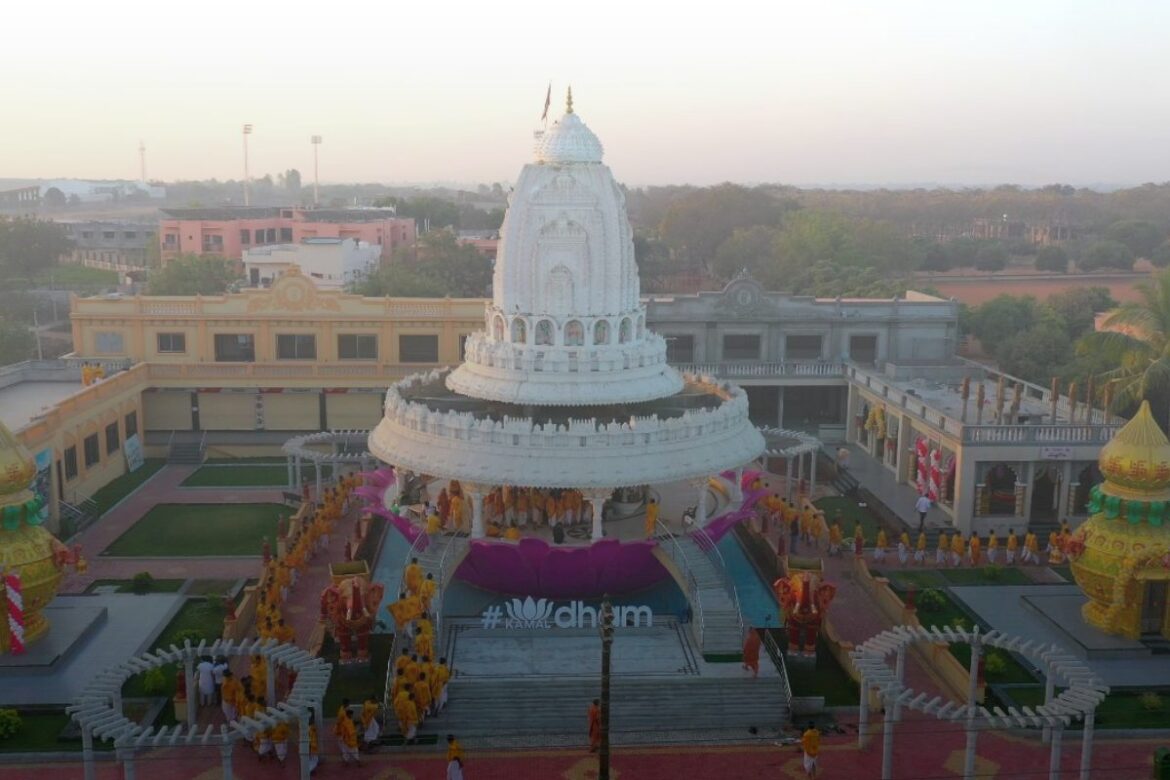Table of Contents
India has a lot of temples, traditions, and philosophies that people from all over the world still look to for inspiration. The Kamaldham Mandir, sometimes called the Kamaldham Mandir Lotus Temple, is one of its many holy sites. It is an interesting place of worship that combines traditional dedication with beautiful design inspired by lotuses.
Unlike churches that are more commercialized or full of tourists, Kamaldham Mandir is a place of spiritual peace and cultural diversity. Because it’s not very well known, it has a real charm that connects deeply with both locals and curious tourists. As soon as you walk through its gates, the atmosphere makes you want to stop, think, and reunite.
This blog will tell you everything you need to know about Kamaldham Mandir, from its history and meanings to its architectural highlights and what visitors can expect. This will make it easier for tourists, spiritual seekers, and culture lovers to connect with this amazing but less well-known place.
The Meaning Behind the Name “Kamaldham”
An important flower in Indian thought is the lotus, which is what the word “Kamal” means in both Sanskrit and Hindi. “Dham” means “abode” or “heavenly residence.” So, Kamaldham means a place where gods live, which is represented by the lotus flower, which is a sign of cleanliness and transcendence.
Hindus believe that the lotus comes out of mud but is not affected by it. It’s a figure of speech for having a spiritual life while being distracted by the world. At Kamaldham Mandir, this idea isn’t just a thought; it’s built into the building itself, into the daily rituals, and even into the community events. All of it has a lotus theme, from the main dome to the flower ponds that go around the building.
Historical Background and Spiritual Roots
Even though Kamaldham Mandir looks modern, its customs go back hundreds of years. It follows the spiritual beliefs of Vaishnavism, which is centered on Lord Vishnu, and Shaivism, which is centered on Lord Shiva. Different belief systems often live together in the same sacred place in India, which is reflected in this dualistic worship.
The temple has become a spiritual center for the city of Surat in Gujarat. Kamaldham Mandir is both a religious spot and a place where good things happen for people. It is run by a dedicated spiritual trust. It helps thousands of people every year through healthcare services, community kitchens, and educational activities.
There is more to Kamaldham Mandir now than there was in the past. It’s a lively place where faith and everyday life meet. It has religious talks, cultural shows, and meditation workshops that both religious people and people who are just interested can attend.
Architectural Brilliance
The structure in the shape of a lotus is the first thing that people notice. Not only is this a design choice, it’s also a moral one. The building represents mental growth and reminds everyone who sees it that they have the power to rise above.
- Main Dome: A beautiful white roof in the shape of a lotus flower sits at the center of the temple. Because of how it’s made, it catches the light beautifully at sunrise and sunset, making an amazing effect.
- Symmetry: Vastu Shastra was used to guide the structure of the temple, making sure that the layout of the structure is in harmony with cosmic forces.
- Intricate Carvings: Both the outside and inside walls have beautiful sculptures of Hindu gods. Each one is made with great care and tells a story.
- Sculpted Pillars: The inner sanctum is held up by marble pillars that are carved with flower patterns and religious symbols.
- Gardens and Ponds: The area around the building has well-kept lawns, lotus ponds, and walking paths. It is a quiet place where people can pray and think.
- Material Use: Many high-quality marble, pink sandstone, and reflective tiles are used to make the structure strong and give it a look that makes people feel calm.
Not only do the faithful come to see this amazing architecture, but so do design students, art fans, and photographers who find ideas in every corner.
Spiritual Significance
The Kamaldham Mandir is more than just a structure. You can feel the spiritual energy in every rite, chant, and wave of incense in this shrine that is alive. The statues of Lord Vishnu, Goddess Lakshmi, and Lord Shiva in the temple are very well made, and they are all worshiped regularly.
The spiritual practice for each day includes:
- Morning and Evening Aarti: The oil lamps, chants, and conch shell sounds that echoed through the rooms made the experience very moving.
- Bhajans and Kirtans: Faith-based music events that are meant to lift the spirit and bring people together.
- Festival Celebrations: People enjoy festivals like Diwali, Janmashtami, Maha Shivaratri, and Navratri with parades, lots of decorations, and prayers for everyone.
- Meditation Halls: Certain places with few decorations and no noise can block out are perfect for deep meditation.
- Scriptural Discourses: A lot of talks about the Bhagavad Gita, the Ramayana, and other holy books help keep people emotionally interested.
Many tourists have talked about how this divine place changed their lives by making them feel at peace, giving them clarity, or just giving them a new sense of purpose.
Kamaldham Mandir vs. Lotus Temple in New Delhi
People may think of the more famous Lotus Temple in New Delhi when they see the design of the lotus flower, but the two have very different spiritual and cultural purposes.
| Feature | Kamaldham Mandir | Lotus Temple |
| Religion | Hinduism | Bahá’í Faith |
| Location | Surat, Gujarat | New Delhi |
| Deities Worshipped | Hindu deities (Vishnu, Lakshmi, etc.) | None (universal prayer) |
| Rituals | Aarti, Bhajan, Puja | Silent meditation |
| Atmosphere | Devotional, traditional | Quiet, non-ritualistic |
Both shrines honor the lotus flower, but Kamaldham is based on Hindu myths and rituals, while the Lotus Temple is more for people of all faiths.
What Makes Kamaldham Special for Visitors?
- Spiritual Ambiance: A peaceful environment ideal for prayer, reflection, and healing.
- Family-Friendly: It’s designed to accommodate everyone—from children to elderly devotees—with ramps, seating areas, and child-friendly zones.
- Cultural Hub: Regular Sanskrit classes, Vedic chant lessons, and traditional dance performances happen throughout the year.
- Community Work: Initiatives like blood donation camps, free eye checkups, and charity meals make it a hub of humanitarian activity.
- Volunteer Support: Knowledgeable volunteers are always on hand to help guide visitors and explain rituals and symbolism.
How to Reach Kamaldham Mandir
Address: [Insert Local Address of Kamaldham Mandir, Surat]
- By Air: Surat International Airport is just 20–30 minutes away. Taxis and rideshare apps are readily available.
- By Train: The Surat Railway Station is well-connected with major cities and about 10 km from the temple.
- By Road: Public buses, autorickshaws, and private vehicles can easily take you there. Ample parking is available.
Local eateries, small handicraft shops, and rest areas near the temple make your visit convenient and pleasant.
Nearby Places Worth Visiting
When planning a trip to Kamaldham, consider extending your visit to explore these nearby locations:
- ISKCON Temple Surat: Known for its grandeur and spiritual vibrancy.
- Dutch Garden: A historical site with colonial-era landscaping.
- Sarthana Nature Park: Perfect for a peaceful walk or family outing.
- VR Mall Surat: Modern shopping and food court experiences.
- Gopi Talav: A scenic lake that’s great for boating and sunset views.
Local Legends and Anecdotes
There are stories all around Kamaldham that go beyond its stone walls. People who live here often tell stories of miraculous blessings that happened after they prayed here, ranging from illnesses getting better to job moves that they didn’t expect.
A famous story says that a farmer in the area prayed for rain during a dry time and the next day there was an unexpected downpour. Some people think these are just accidents, but for many devotees, they prove that the temple has divine energy.
Visitor Tips
To make the most of your visit:
- Wear modest clothing and carry a scarf or shawl to cover your head.
- Photography is permitted outside but not inside the inner sanctum.
- Arrive early in the morning or after sunset for a cooler and quieter experience.
- Bring traditional offerings like flowers, sweets, or incense sticks.
- Check the temple’s event schedule in advance, especially during festival seasons.
Read More: Nainital to Neem Karoli Baba Distance
Conclusion
Kamaldham Mandir Lotus Temple has something very special for everyone, whether they want to connect with God, get creative ideas, or just find peace and quiet. It’s a place that moves both your eyes and your heart.
Don’t miss this temple the next time you’re in Gujarat. Experience the peaceful mix of religion, culture, and building that only Kamaldham can offer.
Follow Go Plan Ready to get more travel tips, insider tips, and culture stories from India and other places.
Frequently Asked Questions (FAQ)
Is there an entry fee to visit Kamaldham Mandir?
No, entry is free for all visitors.
Are non-Hindus allowed to enter?
Yes, visitors of all faiths are welcome to explore the temple respectfully.
What are the temple opening hours?
Typically open from 6:00 AM to 9:00 PM. Aarti times may vary by day or festival.
Are photography and videography allowed?
Yes, but avoid flash and do not shoot inside the sanctum unless permitted.
Is there a dress code?
Modest attire is expected. Carrying a scarf or shawl is recommended.
Can I get Prasad or food at the temple?
Yes, Prasad is usually offered after aarti. The temple also hosts community meals during events.
How long should I plan for my visit?
A typical visit lasts 1–2 hours, but you may stay longer for meditation or attending rituals.

